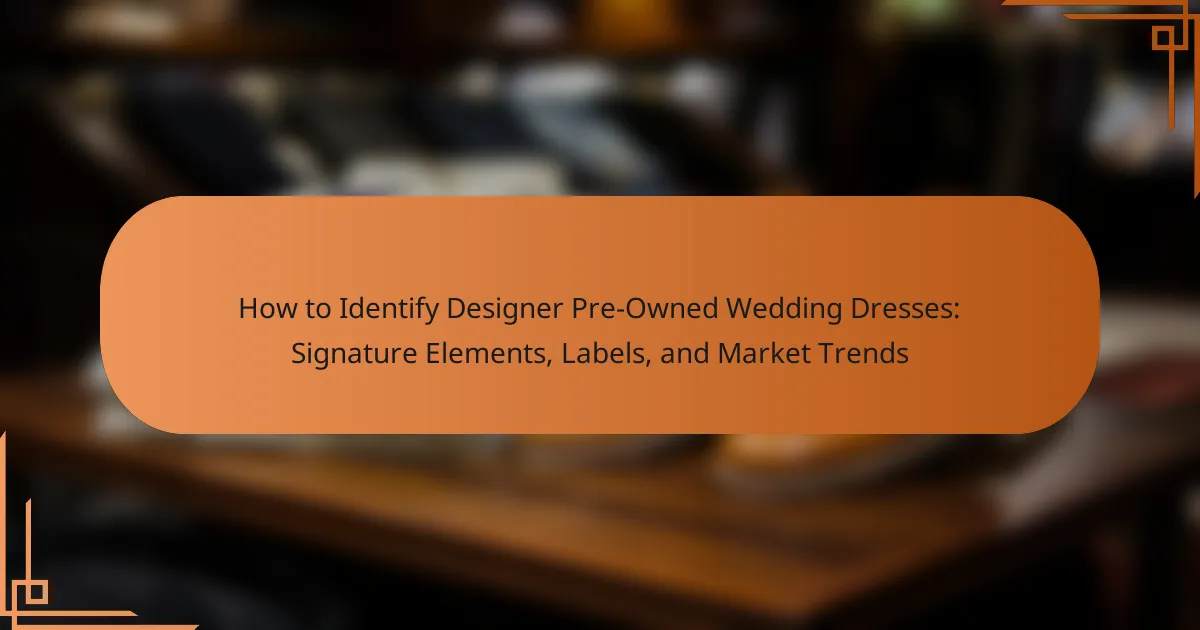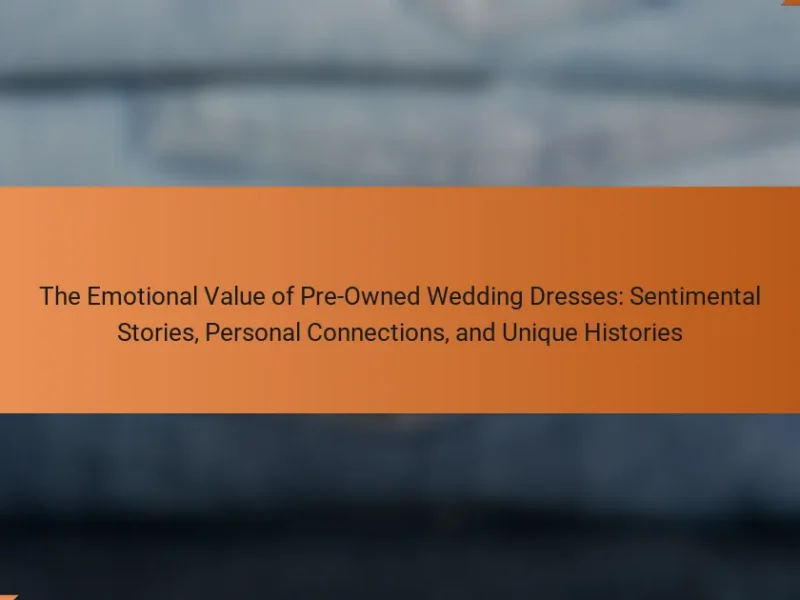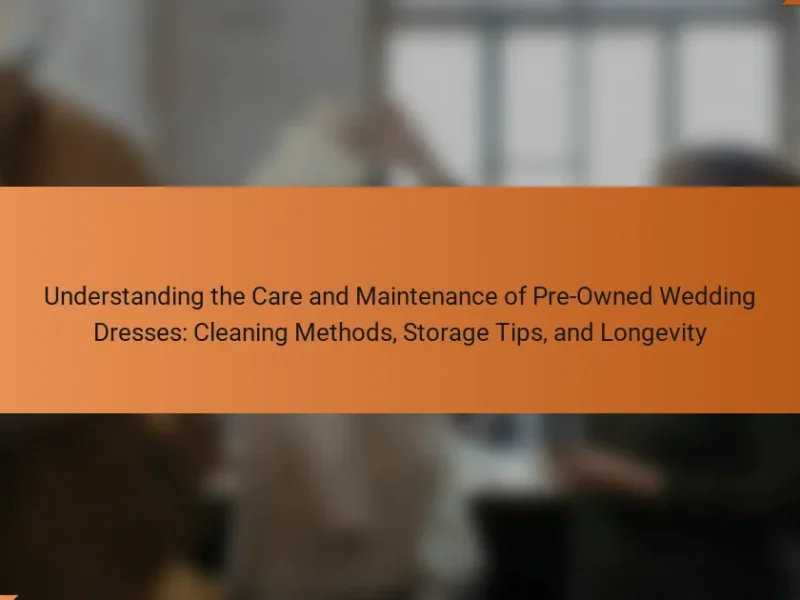Identifying designer pre-owned wedding dresses involves examining key elements such as brand labels, craftsmanship, and unique identifiers. Authentic designer dresses typically feature clear labels and high-quality materials, along with distinctive design elements. To ensure authenticity, it’s important to check for serial numbers and conduct research on the designer’s signature styles. Resources for verification include online platforms, bridal boutiques, and fashion magazines, which provide valuable insights into current trends and authenticating services. This guide offers essential tips for assessing the authenticity and value of pre-owned designer wedding dresses, ensuring a smart purchasing decision.
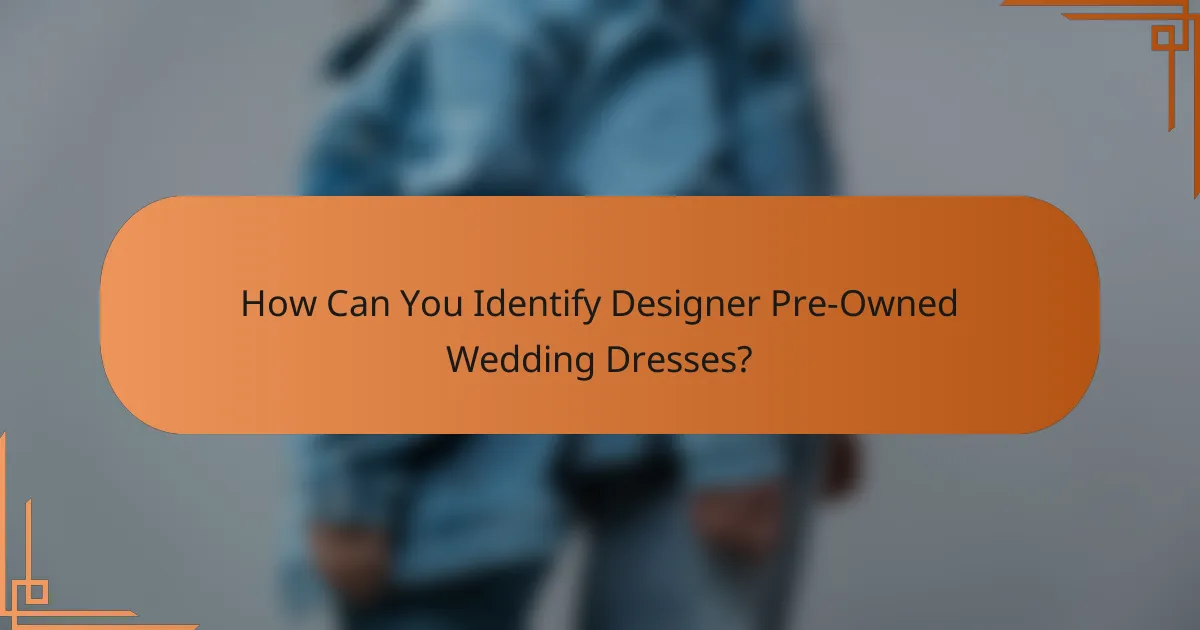
How Can You Identify Designer Pre-Owned Wedding Dresses?
To identify designer pre-owned wedding dresses, examine the label and brand details. Authentic designer dresses typically feature clear brand labels. Look for specific tags that indicate the designer’s name and collection.
Check for quality craftsmanship, including intricate stitching and high-quality fabrics. Designer gowns often use luxurious materials like silk or satin. Inspect the dress for unique design elements that are characteristic of the designer.
Authentic pieces may also have a unique serial number or authenticity card. Research the designer’s signature styles to compare. Familiarize yourself with common market trends for pre-owned designer dresses.
This knowledge helps you differentiate between genuine and counterfeit items.
What Key Features Distinguish Designer Wedding Dresses?
Designer wedding dresses are distinguished by their unique craftsmanship, high-quality materials, and exclusive designs. They often feature intricate detailing, such as hand-embroidery and beading. The use of luxurious fabrics like silk, lace, and tulle is common in these dresses. Designer labels typically ensure a perfect fit through tailored construction. Limited production runs contribute to their exclusivity. Additionally, many designer wedding dresses showcase innovative silhouettes and fashion-forward styles. Renowned designers often have signature elements, such as specific cuts or embellishments, that make their creations instantly recognizable. These features collectively elevate the dress’s status and value in the bridal market.
How Do Fabric Quality and Stitching Reflect Designer Status?
Fabric quality and stitching are key indicators of designer status. High-end designers use premium fabrics like silk, chiffon, and lace. These materials enhance the garment’s aesthetic and durability. Superior stitching techniques, such as French seams and hand-stitched details, showcase craftsmanship. Designers often employ skilled artisans for meticulous construction. This level of detail elevates the garment’s perceived value. For example, brands like Chanel and Dior are known for their exceptional fabric choices and precision stitching. Collectors and buyers often seek these attributes in pre-owned wedding dresses. The presence of high-quality fabric and expert stitching can significantly increase resale value.
What Signature Elements Should You Look For?
Signature elements to look for in designer pre-owned wedding dresses include distinctive stitching and high-quality fabrics. These dresses often feature unique embellishments like lace or beading that signify designer craftsmanship. Labels and tags can also indicate authenticity, with many designers using specific logos or tags. Additionally, the silhouette and cut may reflect the designer’s signature style, making it recognizable. Finally, limited edition pieces or those with unique patterns can serve as indicators of designer origin. These characteristics help differentiate authentic designer dresses from replicas or lower-quality alternatives.
Why Are Labels Important When Identifying Designer Dresses?
Labels are important when identifying designer dresses because they provide authenticity and brand recognition. Designer labels indicate the garment’s origin and craftsmanship. They often include specific details such as the designer’s name, logo, and care instructions. These details help consumers distinguish genuine designer pieces from counterfeits. Additionally, labels can reveal the dress’s collection and season, enhancing its value. For instance, a label from a renowned designer like Chanel or Gucci signifies high quality and exclusivity. The presence of a label can significantly affect resale value in the fashion market. Therefore, labels serve as a key indicator of a dress’s legitimacy and worth.
What Are the Most Recognizable Designer Labels?
The most recognizable designer labels include Chanel, Gucci, Louis Vuitton, and Prada. Chanel is known for its timeless elegance and iconic quilted bags. Gucci stands out with its bold designs and distinctive logo. Louis Vuitton is famous for its luxury luggage and monogram canvas. Prada is celebrated for its innovative styles and high-quality materials. These brands have a significant presence in the fashion industry and are often associated with luxury and prestige. Their logos and products are widely recognized globally, making them symbols of high fashion.
How Can You Verify the Authenticity of a Label?
To verify the authenticity of a label, examine its details closely. Check for consistent font and logo placement. Authentic labels typically have high-quality stitching and materials. Compare the label with known authentic examples from the designer. Research any serial numbers or codes on the label for verification. Consult the designer’s official website for reference images. Seek expert opinions if uncertain about authenticity. Documented proof of purchase can also support authenticity claims.
What Market Trends Should You Be Aware Of?
Current market trends in designer pre-owned wedding dresses include a rise in sustainability and eco-conscious consumerism. More brides are opting for second-hand dresses to reduce waste. The demand for unique, vintage styles is increasing as brides seek individuality. Online marketplaces for pre-owned wedding dresses are expanding rapidly. Social media platforms are influencing trends, showcasing real brides in unique gowns. Price sensitivity is notable, with many brides seeking affordable luxury options. Additionally, designer collaborations with resale platforms are becoming common. These trends highlight a shift towards more thoughtful purchasing decisions in the wedding industry.
How Do Fashion Trends Influence the Value of Pre-Owned Dresses?
Fashion trends significantly influence the value of pre-owned dresses. When a trend gains popularity, demand for similar styles increases. This heightened demand can elevate the resale prices of pre-owned dresses that fit the trend. For instance, a resurgence of vintage styles can boost the value of dresses from previous decades. Conversely, when trends fade, the value of related pre-owned dresses may decline. Market data indicates that dresses from trending designers often see a price increase of up to 30%. Seasonal trends also play a role; summer dresses may fetch higher prices in spring. This relationship between fashion trends and value is evident in resale platforms tracking sales data.
What Seasonal Trends Affect Designer Wedding Dress Availability?
Seasonal trends significantly influence designer wedding dress availability. Spring and summer are peak wedding seasons, leading to higher demand for dresses. Many designers release new collections in early spring, increasing availability during this time. Fall and winter weddings are less common, resulting in fewer dresses being produced. Additionally, bridal boutiques often have seasonal sales, affecting stock levels. Designers may also limit production to create exclusivity, impacting availability. Seasonal trends thus dictate both supply and demand in the designer wedding dress market.
How Do You Assess the Condition of Pre-Owned Wedding Dresses?
To assess the condition of pre-owned wedding dresses, examine the fabric for stains and discoloration. Check the seams for fraying or unraveling. Inspect the lining for any tears or damage. Look for missing or damaged embellishments, such as beads or lace. Evaluate the overall structure for any signs of wear. Consider the dress’s age and whether it has been professionally cleaned. Research indicates that proper assessment can enhance resale value and buyer satisfaction.
What Are Common Signs of Wear and Tear to Look For?
Common signs of wear and tear to look for in designer pre-owned wedding dresses include frayed seams, discoloration, and fabric pilling. Frayed seams indicate structural weakness, which can affect the dress’s overall appearance. Discoloration may result from exposure to light or improper storage, impacting the dress’s color integrity. Fabric pilling occurs when fibers break down, leading to a worn look. Additionally, check for loose beads or embellishments, which can detract from the dress’s elegance. Stains, especially on the hem, can signal previous use and may be difficult to remove. Lastly, inspect the zipper functionality; a malfunctioning zipper can indicate significant wear.
How Can You Determine if a Dress is Worth the Investment?
To determine if a dress is worth the investment, assess its quality, brand, and potential resale value. High-quality materials and craftsmanship indicate durability. Renowned designer brands often retain value over time. Research market trends to understand demand for specific styles or designers. Dresses that are timeless or have unique features typically appreciate in value. Additionally, check the condition of the dress and any alterations made. A well-maintained dress can be a smart investment. Lastly, consider the original retail price versus current market listings for similar dresses. This comparison can highlight its worth.
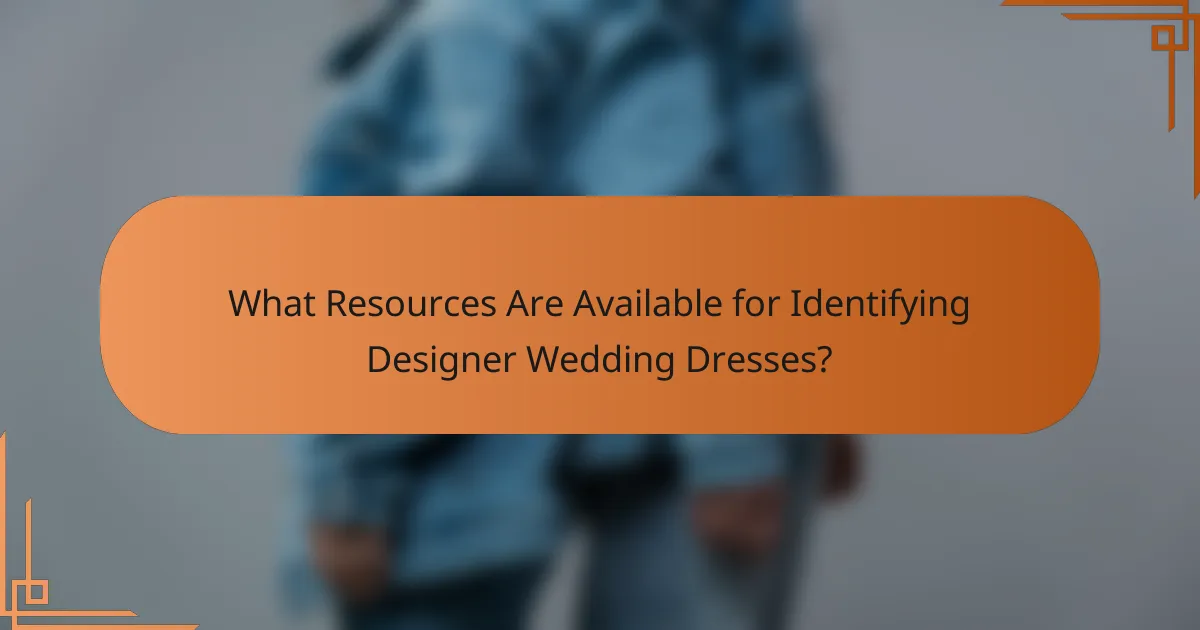
What Resources Are Available for Identifying Designer Wedding Dresses?
Resources for identifying designer wedding dresses include online platforms, bridal boutiques, and fashion magazines. Websites like The Knot and WeddingWire provide extensive listings and reviews. Bridal boutiques often have knowledgeable staff who can assist in identifying designer labels. Fashion magazines, such as Vogue and Harper’s Bazaar, showcase current designer trends and collections. Social media platforms like Instagram and Pinterest also feature designer wedding dresses, providing visual references. Additionally, authentication services and online forums can help verify the authenticity of designer pieces. These resources collectively aid in recognizing and authenticating designer wedding dresses.
How Can Online Platforms Assist in Identifying Designer Dresses?
Online platforms assist in identifying designer dresses through advanced search filters and curated collections. Users can search by brand, style, and size to find specific designer items. Many platforms feature high-resolution images and detailed descriptions, showcasing signature elements of designer dresses. User reviews and ratings provide insights into authenticity and quality. Some platforms employ expert authentication services to verify designer labels. Market trends are often analyzed, helping users understand the value of specific designs. This data-driven approach enhances the buying experience for pre-owned designer dresses.
What Are the Best Websites for Buying Pre-Owned Designer Dresses?
The best websites for buying pre-owned designer dresses include The RealReal, Poshmark, and Vestiaire Collective. The RealReal offers a wide selection of authenticated luxury items. Poshmark allows users to buy and sell directly from each other. Vestiaire Collective specializes in high-end fashion and provides a curated selection. These platforms have gained popularity due to their user-friendly interfaces and extensive inventory. Additionally, they provide authentication services to ensure quality and legitimacy.
How Can Social Media Help You Spot Trends and Authenticity?
Social media can help you spot trends and authenticity by providing real-time insights into consumer preferences. Platforms like Instagram and Pinterest showcase popular styles through user-generated content. This content often reflects current fashion trends, including designer pre-owned wedding dresses. Hashtags allow users to track specific styles and brands, revealing popularity and authenticity. Social media influencers often highlight authentic pieces, offering credibility to certain brands. Additionally, the engagement metrics on posts can indicate which trends resonate with audiences. Analyzing comments and shares can provide further validation of authenticity. This way, social media serves as a valuable tool for identifying both trends and genuine products in the fashion industry.
What Professional Services Can Help with Identification?
Professional services that can help with identification include appraisers, authentication experts, and consignment shops. Appraisers provide valuation and authenticity assessments for designer dresses. Authentication experts specialize in verifying the legitimacy of fashion items. Consignment shops often have experienced staff who can identify designer labels and trends. These professionals use their knowledge of brand history, materials, and craftsmanship to assist consumers. Their expertise ensures that buyers make informed decisions when purchasing pre-owned wedding dresses.
How Do Appraisers Evaluate Designer Wedding Dresses?
Appraisers evaluate designer wedding dresses by assessing several key factors. They examine the dress’s brand, craftsmanship, and condition. The designer label significantly influences the dress’s value. High-end brands like Vera Wang or Monique Lhuillier command higher prices. Appraisers also check for quality materials, such as silk or lace. The dress’s overall condition, including any stains or damages, affects its worth. Historical sales data for similar dresses provides a benchmark for valuation. Finally, market demand can fluctuate, impacting the appraisal.
What Role Do Consignment Shops Play in the Market?
Consignment shops play a significant role in the market by facilitating the resale of pre-owned goods. They provide a platform for individuals to sell items they no longer need. This process promotes sustainability by extending the lifecycle of products. Consignment shops often specialize in niche markets, such as designer clothing or wedding dresses. This specialization attracts consumers seeking unique or high-quality items at lower prices. According to a report by ThredUp, the secondhand market is projected to reach $64 billion by 2024. Additionally, consignment shops help reduce waste by encouraging recycling and reusing goods. They also contribute to local economies by supporting small businesses and creating jobs.
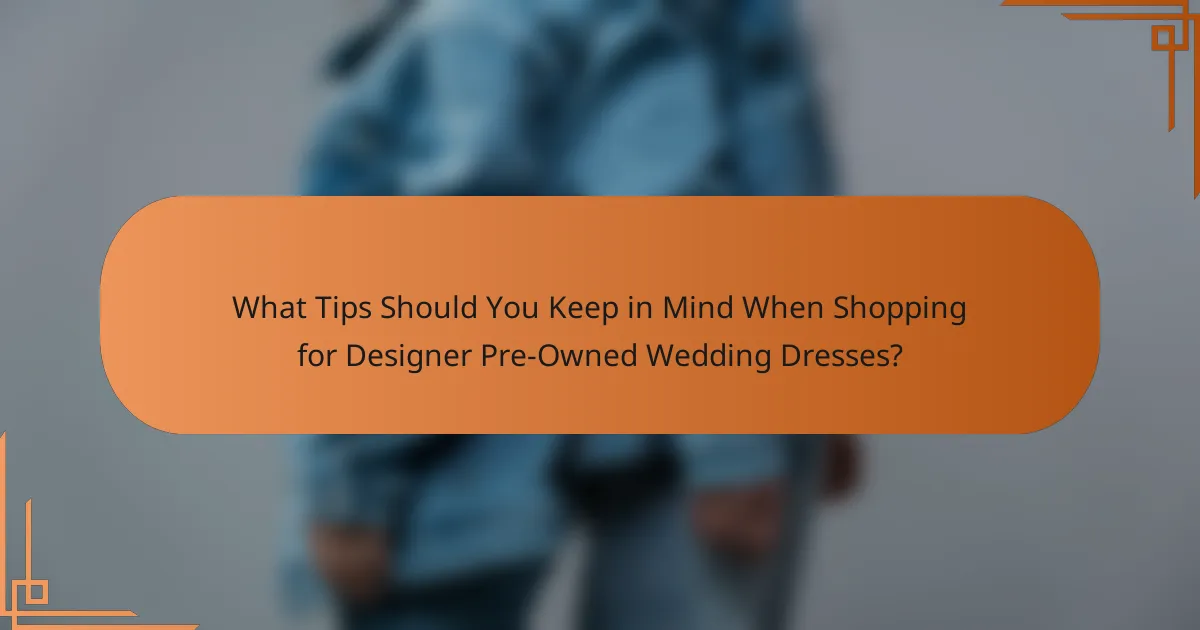
What Tips Should You Keep in Mind When Shopping for Designer Pre-Owned Wedding Dresses?
When shopping for designer pre-owned wedding dresses, prioritize authenticity verification. Check for designer labels and unique identifiers like serial numbers. Inspect the dress for signs of wear, such as fraying or discoloration. Research the original retail price to assess value. Consider the dress’s condition and any necessary alterations. Understand the return policy in case the dress does not meet expectations. Seek reputable sellers with positive reviews. Use online resources to compare prices and styles effectively.
How Can You Make Informed Decisions When Purchasing?
To make informed decisions when purchasing designer pre-owned wedding dresses, research is essential. Begin by identifying reputable sellers and platforms specializing in pre-owned dresses. Check for authenticity by reviewing labels and signature elements associated with the designer. Compare prices across multiple sources to gauge market trends. Reading customer reviews can provide insights into the quality and condition of dresses. Additionally, understanding return policies is crucial in case the dress does not meet expectations. Lastly, consider seeking professional opinions or appraisals for high-value items to ensure a sound investment.
What Questions Should You Ask the Seller?
What questions you should ask the seller include inquiries about the dress’s condition, alterations, and authenticity. Ask if there are any visible flaws or damages. Inquire about the dress’s history, including previous ownership and how often it was worn. Confirm if the dress comes with original tags or receipts. Request details on the designer and collection year. Verify the seller’s return policy in case the dress does not meet expectations. These questions help ensure that the purchase is informed and satisfactory.
How Do You Negotiate Prices for Pre-Owned Dresses?
To negotiate prices for pre-owned dresses, start by researching the dress’s market value. Check similar listings online to understand pricing trends. When approaching the seller, express genuine interest in the dress. Politely inquire if they are open to negotiating the price. Offer a reasonable counter-offer based on your research. Highlight any flaws or wear that could justify a lower price. Be prepared to walk away if the price does not meet your budget. This shows the seller you are serious about your offer. Effective negotiation can often lead to a mutually beneficial agreement.
What Are Common Mistakes to Avoid When Buying Pre-Owned Wedding Dresses?
Common mistakes to avoid when buying pre-owned wedding dresses include neglecting to check the dress’s condition. Buyers should thoroughly inspect for stains, tears, or alterations. Ignoring the seller’s reputation can lead to purchasing from unreliable sources. It’s essential to research the seller’s reviews and ratings. Failing to consider the dress size is another mistake. Wedding dresses often run small, so accurate measurements are crucial. Not asking about the dress’s history can result in surprises. Understanding its previous use and cleaning history is important. Lastly, overlooking return policies can pose risks. Buyers should ensure they have options in case the dress doesn’t meet expectations.
How Can You Ensure You Don’t Overpay?
Research market prices for similar designer pre-owned wedding dresses. Compare listings on multiple platforms to gauge average costs. Verify the authenticity of the dress and its designer label. Check for any signs of wear or damage that may affect value. Use price comparison tools or apps specifically designed for fashion. Consult with experts or bridal boutiques for insights on fair pricing. Ensure you understand the dress’s original retail price for context. By following these steps, you can make informed purchasing decisions and avoid overpaying.
What Should You Consider Regarding Alterations and Fit?
Consider the original design and fabric of the wedding dress when making alterations. Alterations can impact the overall aesthetic and integrity of the garment. Ensure that the dress fits well in key areas such as the bust, waist, and hips. A well-fitted dress enhances comfort and appearance. Consult with a professional tailor experienced in bridal alterations. They can provide insights on what adjustments are feasible without compromising the design. Additionally, factor in the cost of alterations in your budget. Understanding the limitations of the fabric is crucial, as some materials may not hold up well to extensive changes.
The main entity of the article is designer pre-owned wedding dresses. This comprehensive guide covers how to identify authentic designer dresses by examining labels, craftsmanship, and unique design elements. Key features distinguishing designer gowns include high-quality fabrics and intricate detailing, while market trends reveal a growing demand for sustainable and vintage styles. The article also discusses the importance of verifying authenticity through labels and professional services, as well as tips for making informed purchasing decisions to ensure value and satisfaction.
